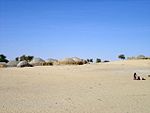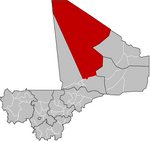Timbuktu
This is your travel guide for Timbuktu
1 : Djinguereber Mosque [1.5 hrs]
The Djinguereber Mosque is one of the most famous landmarks in Timbuktu, built in 1327 by the architect Abu Ishaq es-Sahili. This UNESCO World Heritage Site is an excellent example of Sudano-Sahelian architecture and is made from mud bricks. Visitors can admire its intricate designs and learn about its historical significance as a center of Islamic scholarship and culture.
2 : Tomb of Askia [1 hr]
The Tomb of Askia is another UNESCO World Heritage Site located in Timbuktu, built in the 15th century for the Songhai emperor Askia Muhammad. This impressive structure is known for its unique architectural style, which combines both Islamic and traditional African elements. The tomb serves as a reminder of the rich history of the region and the influence of the Songhai Empire.
3 : Sankore Mosque [1 hr]
The Sankore Mosque, established in the 14th century, is one of the three great mosques of Timbuktu and is renowned for its role as a center of learning. It was part of the ancient university that attracted scholars from across the Muslim world. Visitors can explore the mosque’s beautiful architecture and appreciate its historical importance in the spread of knowledge and culture.
4 : The Museum of Timbuktu [1 hr]
The Museum of Timbuktu showcases the rich history and cultural heritage of the city, featuring artifacts, manuscripts, and exhibits related to the ancient trade routes and Islamic scholarship. The museum provides insight into the city’s past and its role as a major center of trade and learning in West Africa. It is a must-visit for those interested in the history of Timbuktu.
5 : Festival au Désert [2 hrs]
The Festival au Désert is an annual music festival held in Timbuktu, celebrating the rich musical heritage of the Tuareg people and other cultures of the Sahara. This vibrant event features performances by local and international artists, showcasing traditional music and dance. Attending the festival offers a unique opportunity to experience the local culture and connect with the community.
Background Info
Weather
Average temperature ranges from 25°C to 40°C, with low rainfall and humidity levels; air quality can vary due to dust storms.
Language
The primary language spoken in Timbuktu is Tamasheq, a variety of the Tuareg language, along with French as the official language.
Cost Of Living
The cost of living index in Timbuktu is relatively low compared to urban centers, with affordable local markets and basic accommodations.
Other
Timbuktu is historically significant as a center of trade and Islamic scholarship, known for its ancient manuscripts and cultural heritage.
Timbuktu Cercle – cercle of Mali
Location: Timbuktu, Taoudenit Region , Mali![]()
Summary: Timbuktu Cercle Summary
Weather: Timbuktu Cercle Forecast
Population: 124,546 (2009)
Area: 347,488 sq km
Coordinates: 20.833, -3.333
Timezone: (UTC+00:00) Mali Time


